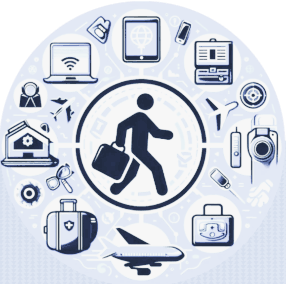Traveling is exciting but can sometimes come with unexpected risks. Being prepared with self-defense knowledge isn’t just about learning to fight—it’s about staying safe and feeling confident while exploring new places.
One key aspect is understanding common travel-related threats. Things like petty theft, scams, and minor confrontations can happen. Knowing what could go wrong helps in being prepared for these situations.
Mental preparedness and situational awareness are also crucial. This means staying alert, being aware of your surroundings, and trusting your gut. If something feels off, it probably is. Always have an exit plan and know the safest route to your hotel or accommodation.
Lastly, legal considerations are something every traveler should keep in mind. Different countries have different laws regarding self-defense. In some places, even carrying a small self-defense tool could get you in trouble. So, it’s essential to research and understand local laws before you pack.
Top 5 Self-Defense Techniques Every Traveler Should Know
Knowing some basic self-defense techniques can be a game-changer when you’re out and about. Here are five techniques that are practical and easy to remember:
Technique 1: The Art of De-escalation. Sometimes, the best way to handle a confrontation is to prevent it from escalating. This means staying calm, using a firm but polite tone, and non-threatening body language. Often, showing that you’re not an easy target can make a potential attacker think twice.
Technique 2: Basic Striking and Blocking. Understanding how to properly throw a punch or block one can help. Placing your weight behind your strike and targeting vulnerable areas like the nose, throat, or groin can maximize the impact. Learning a few basic blocks will also help you defend against incoming attacks.
Technique 3: Evasive Maneuvers and Escaping Holds. Learning how to slip out of holds or avoid grabs is crucial. Techniques like twisting out of wrist grabs or using leverage to break free from chokeholds can be lifesavers. Focus on movements that allow you to escape quickly and create distance.
Technique 4: Using Everyday Objects as Weapons. Items like pens, keys, or even a rolled-up magazine can become effective self-defense tools. The idea is to use what you have on hand to protect yourself. Training with these objects can give you the confidence to use them if needed.
Technique 5: Self-Defense Tools and Gadgets. Carrying self-defense gadgets like pepper spray or a personal alarm can offer extra protection. Familiarize yourself with how to use these tools effectively. Remember to comply with local regulations regarding the possession of these items.
Practical Tips for Practicing Self-Defense Techniques
Finding self-defense classes or workshops can be helpful. Look for local classes before your trip or find workshops in your destination city. Many offer beginner sessions that cover the basics in a few hours.
Practicing techniques regularly is crucial. Consistency helps build muscle memory, so if a situation arises, you’ll react instinctively. Set aside some time each week to go over the moves you’ve learned.
Virtual reality or simulation training can be a fun, immersive way to practice. Programs that mimic real-life scenarios can improve your reaction time and decision-making skills.
Pairing up with a travel buddy for practice can make the learning process more enjoyable and effective. You can simulate different scenarios together and provide each other with constructive feedback.
Staying updated with new self-defense strategies is important. Follow reputable self-defense instructors or organizations on social media, or subscribe to online courses. Continuous learning helps in staying prepared for any new types of threats.
Essential Safety Tips Beyond Physical Self-Defense
Blending in with local customs and surroundings can reduce the chance of drawing unwanted attention. Researching and wearing appropriate clothing and respecting local norms can help you fit in and avoid unnecessary scrutiny.
Securing personal belongings with anti-theft measures is a must. Invest in items like anti-theft bags, money belts, and luggage locks. This makes it harder for pickpockets and thieves to rob you.
Staying connected with a trusted contact back home provides an extra layer of security. Share your itinerary with someone you trust, and check in with them regularly. This ensures that someone knows your whereabouts and can alert authorities if something goes wrong.
Using technology for safety is a smart move. Download safety apps, use GPS tracking, and set up emergency contacts. Devices like portable chargers ensure your phone is always ready to use.
Maintaining a calm and cautious demeanor in unfamiliar areas keeps you alert. Avoid isolated places at night, and always be aware of your surroundings. If you feel uneasy, leave the area immediately. Trust your instincts.

